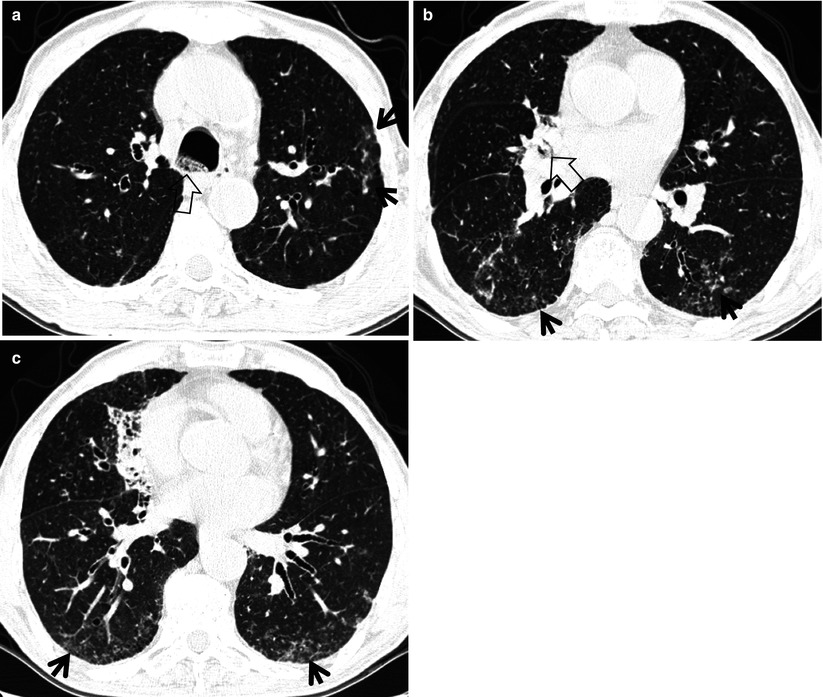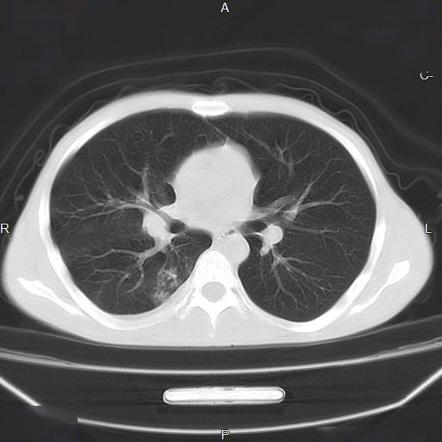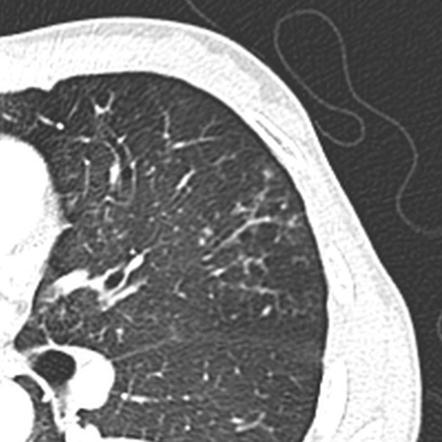tree in bud opacities pneumonia
Distal pulmonary vasculature More specifically the pattern can be manifest becaus. 3 Aspiration is also a common cause of the tree-in-bud formation.

Hrct Scan Of The Chest Showing Diffuse Micronodules And Tree In Bud Download Scientific Diagram
Pneumonia due to respiratory syncytial virus in a 23-year-old man with leukemia.

. And tree-in-bud branching opacities detected throughout both lung fields after aspiration. 1012 Poorly defined centrilobular nodules associated with branching linear and nodular opacities ie tree-in-bud sign are the typical HRCT findings of infective bronchiolitis frequently. Interstitial pneumonia Parenchymal infection.
Vealed scattered linear nodular and tree-in-bud opacities involving the bilateral apices and the upper middle and lower lobes of the right lung suggestive of bronchiolitis. Distal airways more common 2. A young male patient who had a history of fever cough and respiratory distress presented in the emergency department.
In radiology the tree-in-bud sign is a finding on a CT scan that indicates some degree of airway obstruction. Pneumonia due to respiratory syncytial virus in a 23-year-old man with leukemia. As in this case renal cell carcinoma is one of the most common malignancies that may produce this vascular cause of tree-in-bud pattern.
Although initially described in 1993 as a thin-section chest CT finding in active tuberculosis TIB opacities are by. There is no lower lobe predominance as the distribution is quite diffuse. Seasonal influenza in adults.
Mycobacterium avium complex is the most common cause in most series. In radiology the tree-in-bud sign is a finding on a CT scan that indicates some degree of airway obstruction. Mild bronchiectasis had also been noted Figure 1.
Forms include secondary bacterial pneumonia mixed bacterial and viral pneumonia or primary influenza pneumonia. The tree-in-bud sign is a nonspecific imaging finding that implies impaction within bronchioles the smallest airway passages in the lung. 1 direct filling of the centrilobular arteries by tumor emboli and 2 fibrocellular intimal hyperplasia due to carcinomatous endarteritis.
A tree-in-bud pattern of centrilobular nodules from metastatic disease occurs by two mechanisms. 1 It is important for clinicians to remember that this pattern has an extensive. Simply put the tree-in-bud pattern can be seen with two main sites of disease 3.
These small clustered branching and nodular opacities represent terminal airway mucous impaction with adjacent peribronchiolar inflammation. In the acute phase bacterial pneumonia manifests in the form of segmental or lobar consolidation Fig 2 possibly with cavitation and related hilar and mediastinal adenopathies. The purpose of this study was to determine the relative frequency of causes of TIB opacities and identify patterns of disease associated with TIB opacities.
There is no associated bronchiectasis bronchial wall thickening consolidation cavitation or lymphadenopathy. Multiple causes for tree-in-bud TIB opacities have been reported. While the findings of bronchiolitis such as centrilobular nodular opacities and a tree-in-bud pattern are common in aspiration pneumonia they are not typically found in COVID-19 pneumonia 61 62 Fig.
The differential for this finding includes malignant and inflammatory. A young male patient who had a history of fever cough and respiratory distress presented in the emergency department. More extensive lympho - cytic infiltrations may be associated with lymphoid interstitial pneumonia LIP with ground-.
Chest radiography had demonstrated signs of bronchiectasis and several scattered nodules Figure 2. However to our knowledge the relative frequencies of the causes have not been evaluated. 2 However the classic cause of tree-in-bud is Mycobacterium tuberculosis especially when it is active and contagious and associated with cavitary lesions.
There are two major pathologic patterns of viral pneumonia. A chest radiograph showed bilateral nodular opacities with a left lower lobar consolidative opacity Fig 1A 1B. The patient underwent CT scanning of the chest which showed areas of nodular infiltration in the lower lobes with tree.
Tree-in-bud refers to a pattern seen on thin-section chest CT in which centrilobular bronchial dilatation and filling by mucus pus or fluid resembles a budding tree. Tree-in-bud TIB appearance in computed tomography CT chest is most commonly a manifestation of infection. It is most commonly associated with infectious diseases affecting the bronchioles1 OP resulting in a tree in bud pattern has been previously suggested2 However a clear radiological-pathological correlation of OP filling the bronchioles resulting in a tree in bud pattern has to the best of our knowledge not yet been clearly demonstrated.
HR-CT patterns seen in OP are. Aspiration pneumonia also mostly involves lower lobes and the posterior lung and can manifest as patchy GGOs andor consolidations. Tree-in-bud TIB opacities are a common imaging finding on thoracic CT scan.
Classically bronchiolitis appears as a region of centrilobular nodularity often in a tree-in-bud pattern. Adjacent bronchial wall thickening is also frequently depicted. Usually somewhat nodular in appearance the tree-in-bud pattern is generally most pronounced in the lung periphery and associated with abnormalities of the larger airways.
TIB opacities represent a normally invisible branches of the bronchiole tree 1 mm in diameter that are severely impacted with mucous pus or fluid with resultant dilatation and budding of the terminal bronchioles 2 mm in diameter1 photo. Note the scattered lung nodules surrounded by. Associated focal ground-glass and consolidative opacities may be visualized although this should not the predominant feature.
There are tree-in-bud opacities scattered throughout both lungs. However gram staining and cultures were negative. The purpose of this study was to determine the relative frequency of causes of TIB opacities and identify patterns of disease associated with TIB opacities.
We here describe an unusual cause of TIB during the COVID-19 pandemic. Thin-section CT scan shows peripheral poorly defined centrilobular nodules and tree-in-bud opacities bilaterally. Patients with normal standard physiological pulmonary tests have been shown to have mosaic perfusion and air trapping on HRCT suggestive of bronchiolitis obliterans and a pattern of branching linear opacities like a tree in bud appearance suggestive of bronchiectasis with mucoid secretions.
Tree-In-Bud Pattern A lymphoid interstitial infiltrate in the walls of the small airways follicular bronchiolitis may cause small centrilobular nodules and the tree-in-bud pattern Fig. Organizing pneumonia most commonly results in a patchy bilateral consolidation that has a.

References In Causes And Imaging Patterns Of Tree In Bud Opacities Chest

Pdf Causes And Imaging Patterns Of Tree In Bud Opacities Semantic Scholar

Tree In Bud Sign Radiology Key

References In Causes And Imaging Patterns Of Tree In Bud Opacities Chest

Tree In Bud Pattern Radiology Case Radiopaedia Org

Tree In Bud Pattern Pulmonary Tb Eurorad

Tree In Bud Sign Lung Radiology Reference Article Radiopaedia Org

Tree In Bud Sign Lung Radiology Reference Article Radiopaedia Org
View Of Tree In Bud The Southwest Respiratory And Critical Care Chronicles

Tree In Bud Pattern Semantic Scholar

Pdf Tree In Bud Semantic Scholar

Chest Ct With Multifocal Tree In Bud Opacities Diffuse Bronchiectasis Download Scientific Diagram

Tree In Bud Pattern Radiology Case Radiopaedia Org

Tree In Bud Sign Lung Radiology Reference Article Radiopaedia Org

